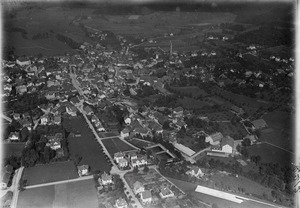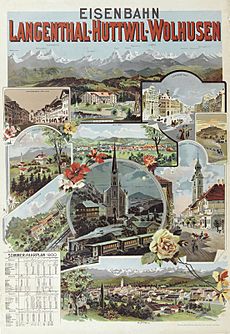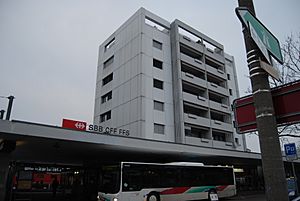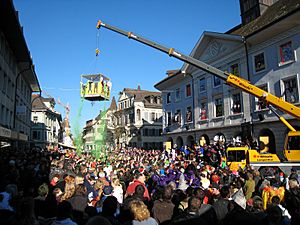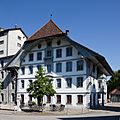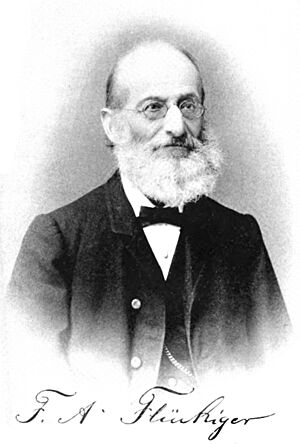Langenthal facts for kids
Quick facts for kids
Langenthal
|
||
|---|---|---|
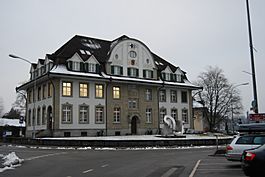
Building in the old town of Langenthal
|
||
|
||
| Country | Switzerland | |
| Canton | Bern | |
| District | Oberaargau | |
| Area | ||
| • Total | 21.13 km2 (8.16 sq mi) | |
| Elevation | 481 m (1,578 ft) | |
| Population
(Dec 2020 )
|
||
| • Total | 15,544 | |
| • Density | 735.64/km2 (1,905.3/sq mi) | |
| Postal code |
4900-4902
|
|
| Surrounded by | Aarwangen, Bleienbach, Lotzwil, Obersteckholz, Roggwil, Thunstetten, Untersteckholz | |
| Twin towns | Brig-Glis (Switzerland), Neviano (Italy) | |
Langenthal is a town and a local government area (called a municipality) in the Oberaargau district. It is located in the canton of Bern in Switzerland.
Langenthal is an important place for education, culture, and business in the Oberaargau region. On January 1, 2010, the municipality of Untersteckholz joined Langenthal. Later, on January 1, 2021, Obersteckholz also became part of Langenthal.
Contents
- Langenthal's Past: A Look at Its History
- Langenthal's Location and Landscape
- Langenthal's Coat of Arms
- People of Langenthal: Demographics
- Important Heritage Sites
- Langenthal's Economy and Jobs
- Religions in Langenthal
- Education in Langenthal
- Getting Around: Transportation
- Sports in Langenthal
- Famous People from Langenthal
- See also
Langenthal's Past: A Look at Its History
Early Settlements and Roman Times
People have lived in the Langenthal area for a very long time. Archeologists have found signs of early settlements from around 4000 B.C. A burial ground from the Hallstatt culture (an ancient European culture) with twelve grave mounds was discovered at Unterhard. There are also remains of two Roman villas in the area.
Langenthal was first mentioned in 861. Back then, it was called marcha in Langatun. This name referred to farms spread out along the Langete river. The name Langatun likely came from an old word for the river and a Gaulish word meaning "fort." Later, around the 15th century, people started calling it Langental, thinking it meant "Langete valley."
How Langenthal Grew: From Abbey to Town
In the 12th century, Langenthal was part of the land owned by the lords of Langenstein. In 1194, they started the Abbey of St. Urban and gave land in Langenthal to the Abbey. Langenthal got its own church in 1197.
After the Langenstein family ended in 1212, the Abbey received more land. The Abbey helped improve farming, especially by bringing in irrigation systems. Over time, the Abbey gained more control over the village.
Bern Takes Control
By 1313, the Kyburg family had the right to hold the main court in Langenthal. When this family died out in 1406, Bern took over this right. Bern's power in Langenthal grew steadily. In 1415, Langenthal officially became part of Bern's territory. However, the Abbey still owned the land and had control over the local court.
The Protestant Reformation in 1528 slightly weakened the Abbey's power. But it continued to collect taxes and choose the village priest until Bern bought these rights in 1808.
Markets and Trade: Langenthal's Economic Boom
During the 16th century, many skilled workers and small businesses moved to Langenthal. In 1571, Bern allowed the town to hold two markets each year. Soon, there were too many goods for just two markets. So, in 1613, a market building called a Kaufhaus was built, and weekly markets began. This building later became the town hall.
By 1616, Langenthal had rules for its busy markets and trade. In 1640, Langenthal became a major center for making and selling linen canvas. This linen was exported to countries like France, Italy, Spain, and Portugal. This success helped the town grow.
Modern Development and Mergers
Langenthal's location on the road from Bern to Zurich (built in 1760) and on the Swiss Central Railway line (opened in 1857) helped it grow even more. Industries like textiles and machines developed. The town got a water supply in 1894 and electricity in 1896.
In 1898, the nearby area of Schoren became part of Langenthal. The population grew from 1,327 people in 1764 to 4,799 by 1900. In the 20th century, Langenthal became famous for making porcelain. By 1957, Langenthal had 10,000 people, and by 1970, it had 13,000. Since 1997, Langenthal has officially been called a "city."
In 2001, Langenthal became "twinned" with Neviano in Italy and Brig-Glis in Switzerland. This means they became partner towns. In 2010, Untersteckholz joined Langenthal, and in 2021, Obersteckholz also merged with the town.
Obersteckholz's History
Obersteckholz was first mentioned in 1255. It was originally owned by the Baron of Langenstein, who gave it to St. Urban's Abbey in 1194. It was part of Langenthal's court until 1406, when it became part of Bern's district of Wangen. After the French invasion in 1798, it was part of the Langenthal district. In 1803, it became an independent municipality.
Langenthal's Location and Landscape
Langenthal is the largest settlement in the Langeten Valley. It includes the old village of Langenthal, many newer parts, the village of Schoren, and since 2010, Untersteckholz.
The total area of Langenthal is about 17.2 square kilometers (6.6 square miles).
- About 23.8% of this land is used for farming.
- About 41.6% is covered by forests.
- About 34.4% has buildings or roads.
- A small part (0.3%) is rivers or lakes.
For example, in the built-up areas, industrial buildings make up 5.1% of the total, while homes and other buildings are 17.8%. Roads take up 8.0%, and parks or sports fields are 2.9%.
Langenthal's Coat of Arms
The official design for Langenthal's coat of arms shows three wavy blue bands on a yellow background. This design has been used since about 1870. However, a flag with a similar design, "yellow and blue with a triple rivulet," was mentioned in a song around 1700.
People of Langenthal: Demographics
Langenthal has a population of about 16,000 people. In 2010, about 19.9% of the people living in Langenthal were foreign nationals. Over the last ten years (2000–2010), the population grew by 5.3%. Most of this growth came from people moving into the town.
Most people in Langenthal (about 85.2%) speak German as their main language. Italian is the second most common language, and Serbo-Croatian is the third.
In 2008, about 48.6% of the population was male and 51.4% was female.
- About 19.7% of the population are children and teenagers (0–19 years old).
- About 61.6% are adults (20–64 years old).
- About 18.7% are seniors (over 64 years old).
The chart below shows how Langenthal's population has changed over time:

Important Heritage Sites
Several places in Langenthal are recognized as important Swiss heritage sites. These include:
- The old Kaufhaus (market building)
- The Old Mill
- The archeological site at Unterhard
The old village of Langenthal and the small village (or hamlet) of Chlyrot are also part of the Inventory of Swiss Heritage Sites.
Langenthal's Economy and Jobs
Langenthal is an important business and industrial hub for its region. It is home to several well-known companies:
- Ammann Group: Makes construction vehicles.
- Motorex Bucher: Produces lubricants.
- KADI AG: A food company.
- Ruckstuhl: Makes textile flooring.
- Lantal Textiles and Création Baumann: Both are textile companies.
In 2011, Langenthal had a low unemployment rate of 2.52%. In 2008, there were over 10,700 people working in the municipality.
- A small number of people worked in farming and forestry (the primary sector).
- Many people (over 3,600) worked in factories and construction (the secondary sector).
- The largest number of people (over 7,000) worked in services, like sales, transportation, hotels, education, and healthcare (the tertiary sector).
Langenthal is a place where many people come to work. In 2000, about 6,600 workers traveled into the municipality for their jobs, while about 3,100 residents traveled out to work elsewhere. This means Langenthal brings in more workers than it sends out. About 16.5% of workers used public transportation, and 43.5% used a private car to get to work.
Religions in Langenthal
In 2000, the main religions in Langenthal were:
- Swiss Reformed Church: About 59.2% of the population.
- Roman Catholic: About 18.5% of the population.
- Other Christian churches: About 6.5% of the population.
- Muslim: About 6.0% of the population.
- Smaller numbers of people were Hindu, Buddhist, or followed other religions.
- About 5.6% of the population said they were not religious.
Education in Langenthal
Education is important in Langenthal. About 39.4% of the population has finished upper secondary education (like high school). About 12.3% have gone on to higher education, such as a university or a specialized college (Fachhochschule).
The school system in the Canton of Bern includes:
- One year of non-required Kindergarten.
- Six years of Primary school.
- Three years of required lower Secondary school, where students are grouped by their abilities.
After lower Secondary, students can continue their schooling or start an apprenticeship (learning a trade on the job).
During the 2009–10 school year, over 1,900 students attended schools in Langenthal. The town has a public library called Regionalbibliothek Langenthal. In 2008, the library had over 35,000 books and other items. It loaned out over 267,000 items that year.
Getting Around: Transportation
Langenthal has four railway stations, making it easy to travel:
- Langenthal: This is a main station with regular trains to big cities like Zürich Hauptbahnhof, Bern, Solothurn, Baden, Lucerne, and Olten.
- Langenthal Süd: Located south of Langenthal, on the way to Lucerne.
- Langenthal Gaswerk and Langenthal Industrie Nord: These are smaller stations for local train lines.
Sports in Langenthal
Langenthal is home to the SC Langenthal ice hockey team. They play in the Swiss League. Their home arena is called Schoren, which can hold 4,500 fans.
Famous People from Langenthal
Many notable people have connections to Langenthal:
- Friedrich August Flückiger (1828–1894): A Swiss pharmacist, chemist, and botanist.
- Carl Friedrich Geiser (1843–1934): A mathematician who studied algebraic geometry.
- Emma Graf (1865–1926): A historian, teacher, and supporter of women's right to vote.
- Karl Jaberg (1877–1958): A Swiss linguist who studied dialects.
- Friedrich Born (1903–1963): A diplomat who helped save thousands of Jewish people in Budapest during World War II.
- Adrian Aeschbacher (1912–2002): A Swiss classical pianist.
- Heinz Holliger (born 1939): A famous oboist, composer, and conductor.
- Johann Schneider-Ammann (born 1952): A businessman and politician who lives in Langenthal.
- Cornelia Meyer (born 1959): An international economist and media commentator.
- Pedro Lenz (born 1965): A Swiss writer.
Sports Stars
- Fritz Scheidegger (1930–1967): A Swiss sidecar racer who won two World Championships.
- Christophe Bühler (born 1974): A former Swiss swimmer who competed in the 2000 Summer Olympics.
- Stefan Grogg (born 1974): An ice hockey player who was part of the Swiss Men's National Team.
- Bruno Sutter (born 1977): A Swiss footballer with over 300 club games.
- Rémo Meyer (born 1980): A football player with over 220 club games.
- Fabienne Meyer (born 1981): A former Swiss bobsledder who competed in the 2010 and 2014 Winter Olympics.
- Thomas Reinmann (born 1983): A former Swiss football defender.
- Sven Bärtschi (born 1992): An ice hockey player.
- Carole Howald (born 1993): A Swiss female curler.
See also
 In Spanish: Langenthal para niños
In Spanish: Langenthal para niños





